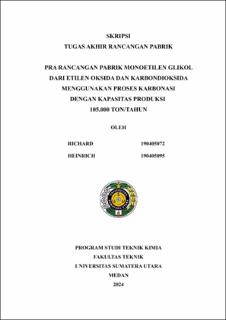Pra Rancangan Pabrik Monoetilen Glikol dari Etilen Oksida dan Karbondioksida Menggunakan Proses Karbonasi dengan Kapasitas Produksi 105.000 Ton/Tahun
Preliminary Design of Monoethylene Glycol Plant from Ethylene Oxide and Carbon Dioxide Using Carbonation Process with a Production Capacity 105,000 Tons/Year

Date
2024Author
Richard, Richard
Heinrich, Heinrich
Advisor(s)
Fatimah
Bani, Okta
Metadata
Show full item recordAbstract
Ethylene glycol is one of the chemicals whose production has not yet met the needs
of industries in Indonesia. Most ethylene glycol is used as a raw material in the
polyester industry, which is a primary raw material for the textile and plastic
industries. The production of ethylene glycol is typically carried out through the
direct hydrolysis of ethylene oxide, but this process has several drawbacks,
including low ethylene glycol conversion rates. Therefore, to maximize ethylene
glycol production, it is proposed to produce ethylene glycol from ethylene oxide
using the carbonation process.This production process consists of several stages:
the initial stage, the carbonation stage, and the hydrolysis stage. The ethylene glycol
plant is planned to be located in Pedamaran, Pekaitan, Rokan Hilir Regency, Riau,
on a 21,126.60 m² site, with a production capacity of 105,000 tons per year. The
plant will operate 24 hours a day for 330 working days per year and employ 175
workers. The business structure of this ethylene glycol plant is a limited liability
company (PT).The establishment and operation of the plant require an investment
capital of IDR 1,071,132,324,144 and production costs of IDR 794,854,143,387.
Based on the feasibility analysis, the plant has a BEP (Break-Even Point) of
41.9878%, an ROI (Return on Investment) of 17.8740%, a POT (Pay-Out Time) of
5 years and 7 months, an RON (Rate of Net Return) of 29.79%, and an IRR (Internal
Rate of Return) of 17.4714%. Based on the economic analysis, it can be concluded
that the preliminary design of the monoethylene glycol plant from ethylene oxide
and carbon dioxide using the carbonation process is feasible to establish.
Collections
- Undergraduate Theses [1239]
